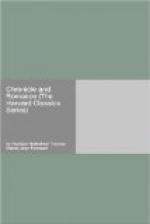with England than when an Englishman was known abroad
by his own cloth, and contented himself at home with
his fine carsey hosen, and a mean slop; his coat, gown,
and cloak of brown, blue, or puke, with some pretty
furniture of velvet or fur, and a doublet of sad tawny,
or black velvet, or other comely silk, without such
cuts and garish colours as are worn in these days,
and never brought in but by the consent of the French,
who think themselves the gayest men when they have
most diversities of jags and change of colours about
them. Certes of all estates our merchants do
least alter their attire, and therefore are most to
be commended; for albeit that which they wear be very
fine and costly, yet in form and colour it representeth
a great piece of the ancient gravity appertaining
to citizens and burgesses, albeit the younger sort
of their wives, both in attire and costly housekeeping,
cannot tell when and how to make an end, as being
women indeed in whom all kind of curiosity is to be
found and seen, and in far greater measure than in
women of higher calling. I might here name a sort
of hues devised for the nonce, wherewith to please
fantastical heads, as goose-turd green, peas-porridge
tawny, popingay blue, lusty gallant, the devil-in-the-head
(I should say the hedge), and such like; but I pass
them over, thinking it sufficient to have said thus
much of apparel generally, when nothing can particularly
be spoken of any constancy thereof.
CHAPTER VIII
OF THE MANNER OF BUILDING AND FURNITURE OF OUR HOUSES
[1577, Book II., Chapter 10; 1587, Book II., Chapter
12.]
The greatest part of our building in the cities and
good towns of England consisteth only of timber, for
as yet few of the houses of the communalty (except
here and there in the West-country towns) are made
of stone, although they may (in my opinion) in divers
other places be builded so good cheap of the one as
of the other. In old time the houses of the Britons
were slightly set up with a few posts and many raddles,
with stable and all offices under one roof, the like
whereof almost is to be seen in the fenny countries
and northern parts unto this day, where for lack of
wood they are enforced to continue this ancient manner
of building. It is not in vain, therefore, in
speaking of building, to make a distinction between
the plain and woody soils; for as in these, our houses
are commonly strong and well-timbered (so that in
many places there are not above four, six, or nine
inches between stud and stud), so in the open champaign
countries they are forced, for want of stuff, to use
no studs at all, but only frankposts, raisins, beams,
prickposts, groundsels, summers (or dormants), transoms,
and such principals, with here and there a girding,
whereunto they fasten their splints or raddles, and
then cast it all over with thick clay to keep out the
wind, which otherwise would annoy them. Certes




